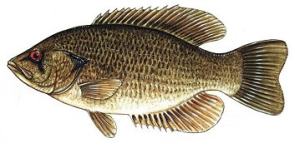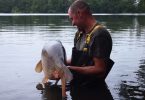The best thing about fishing when we were growing up was that it was just so darn easy to do. All that was required was to walk down a gravel road for a few hundred metres with my brother and then down a twisting, sharply descending path through the woods to the Clearwater River. Then again, if you wanted to get to the other side of the river, you needed to walk across a railway bridge that was, at the time, still in use and consequently fraught with inherent danger.
Rock Bass
The rock bass (Ambloplites ruperstris) was usually a fish that we caught by accident when fishing for Walleyes or Pike. There were times, however, when the big fish weren’t biting that we actually tried to catch them. A Rock bass is a fish that thrives in clear, fresh water with a rocky bottom. It hides in the crevices and shadows of the rocks and darts out to feed on smaller fish and crustaceans. I still am not sure why but downriver from the railway bridge were some incredibly unusual geological formations. On one side of the river (the side not requiring the railway bridge crossing), there was a very deep hole where walleye and catfish hung out when they were not exercising their carnivorous tendencies. On the opposite bank, a lagoon (or cove) formed, with a sandbar in the middle that during hot summers was sometimes visible or even exposed. This left a young angler with two choices during the day, either fish the deep hole for big fish or cross the railway bridge and enjoy the lagoon for the pleasure of actually catching fish. The rock bass on offer in the lagoon were available at the cost of a simple worm on a hook and you really didn’t even need a fishing rod to bring them in.
 Rock Bass
Rock Bass(Ambloplites rupestris)
The rock bass is a species of freshwater fish that can grow to between 6 to 10 inches. It has brilliant red eyes and looks more like something out of the sunfish family than anything like the bass that tend to populate the rivers and lakes of North America. The species thrives due to the omnipresence of the smaller fish and crustaceans in the rivers flowing northward to Hudson Bay in Canada and those flowing downward through the Mississippi River system to the Gulf of Mexico.
Catching rock bass involves teasing a hooked worm into the dark crevice between the rocks until the fish would dart out and take whatever was on offer. The whole experience was deeply satisfying for an angler precisely because it was so visual – you saw the silly fish through the sunlit, clear water attacking the bait and witnessed the moment it was hooked (or not hooked for that matter). Once hooked, you simply lifted up the monofilament, stick, rod or whatever you happened to be fishing with and, voila, the rock bass was yours, at least, to release anyway. I am certain they are tasty fish but no self-respecting fisherman would ever eat one.
The Railway Bridge
If you have never done it before, crossing a railway bridge over a river can be a bit scary – actually even if you have done it before. The problem is twofold. First, you have to walk in measured steps across evenly spaced railway ties (thick wooden slats that make a railroad look like a railroad), making the river appear as an abyss below you. Second, you never really know when a train might want to occupy the same space as you on the bridge.
At a walk, the railway bridge took a few minutes to negotiate. At a jog (which after years of experience we all could do using evenly spaced strides), it would take at most a minute to get across. But when you heard the whistle of a train approaching, you found a way to either cut that minute in half or capitulate and curl up in a metal railway gusset in the middle of the bridge and wait as the train came thundering past. Coiling in your metal gusset, the railway bridge would shake with such tremors that you would be hard pressed to understand why the bridge did not collapse. Afterwards and safely on the other side, a quick descent from the tracks was all that was needed to start fishing on the other side.
The Big Rock at the Lagoon
The seven glaciers that cut through Minnesota during last ice age 10,000 years ago did more than simply remove any real skiing opportunities; rather, each one left sediment and rock, predominantly granite, throughout Minnesota. One such rock rests on the riverbank at the edge of the lagoon on the Clearwater just downriver from the railway bridge. When the water is clear (which one might expect fishing on the “Clearwater”) the rock bass dart out of their hiding places to snap up the bait if tempted just right. A short flick of the wrist as the worm descended into the shadowy crevice would usually do the trick.
With rock bass, you could use whatever potential implements of fishing were at your disposal – even a stick with some weak monofilament line would be enough. The stick-string approach happened quite often because my brother had much more patience in going after the big ones in the deep hole on the opposite shore. He was also stronger, meaning that if he wanted both rods engaged in the deep hole that was pretty much what happened. But he would never deny me some string and a hook to try my luck from the big rock on the other side.
If you stood on the big rock on a bright, sunny day, you could see out before you all the multi-colored granite of orange, red, black and grey refracting light through the pristine water. I often wondered how those beautiful large stones happened to end up just there, on the edge of a river in a little town in northern Minnesota.
Some unusual things have happened in the past when fishing from the big rock. Once I was fishing with a super light-weight piece of monofilament in my hand (no rod – just a stick). Suddenly, a huge carp gingerly swam up, ate my worm and left, breaking my line as if it was a wet spaghetti noodle. I don’t believe I have ever felt so helpless in my life. Perhaps, the next experience on the big rock trumps that and can still gives me goose-bumps to this day.
The World Record
This all led to one special July morning under a pure blue sky. I found myself standing on the big rock. I had crossed the railway bridge early, already bored with fishing for the “big ones” with my brother in the deep hole on the opposite bank. And then it happened. I hooked a fish that made my mind immediately scroll through its entire list of fish: Walleye?, Pike?, Catfish?, Sucker?, Perch?, Guppy?, Eel?… What in the world was this huge fish that just ate my bait? It fought for a moment (quite poorly for its size) before giving up all too quickly and then I simply horsed it in. My brother was already running up the riverbank on the other side; witnessing my reaction, he crossed the bridge in well under a minute to assist. I might per chance of even screamed “help” a couple of times but I will never admit it.
Once the great fish was landed, my brother (huffing and puffing beside me) and I stared at it for a considerable amount of time. After a bit of speculation, we concluded that the gargantuan specimen before us was no less than the world record rock bass. When I say world record, I really mean something that was probably 4 times as big as the official world record rock bass – the
former world record was in fact 3 lbs 10 oz. but we certainly didn’t know that at the time. All we knew was that it was very, very big.
The Triumphant Carry Home
We ran back into the woods behind the lagoon and found a thick, straight stick to carry our prize home. We fed the stick through the gills and mouth of our world record rock bass and carried it home, each bearing an end of the stick on our shoulders. We even carried it over the railway bridge with the confidence of two brothers who knew that even a vengeful god would not let us be run-over by a train on this glorious day.
 Artwork by Susan Ennis
Artwork by Susan Ennis
I guess we all dream of how it might feel – the moment when you think you have done something so incredible that in the future people will sing songs about you. We sang the usual songs as we crossed the bridge on our way home, bearing the weight of our great fish up the twisting pathway to the gravel road above. Once there, no one would ever dare to question our credentials as top rate fishermen as we hauled our catch home. We were more or less certain that by the time we approached our garage a long line of on-lookers would be following our every move and asking questions; the sort of questions one asks a pro fisherman on one of those Saturday, lunker-catching TV programs.
The Invasive Species
As it turns out, things are not always what they seem to be – even rock bass – as my brother and I were soon to learn. We were encountering an invasive species that spelled the beginning of the end of fishing for a good many years on our rivers. To illustrate, spear-fishing used to be a winter activity, something enjoyed by ice-fishermen in a darkened ice-house with the snow scraped off the ice outside. This created an illuminated rectangular hole inside, leaving the fisherman watching something that looked like a big screen TV filled with water. We had two black, iron spears in my family and in one day my brother and I speared 130 (that is not a typo) fish at the height of the in the middle of the summer in just a few hours.
We walked up river in our sneakers from the railway bridge up to the old sawmill dam, stabbing our spears more or less continuously. In every eddy or current respite in the wake of a big rock, we saw them. It was a species of fish that we eventually came to loath – Sheephead (Aplodinotus grunniens). Sheephead entered the Red Lake river system like a swarm of locus in the mid 1970s. This was most likely due to their resiliency to PCBs and the other toxins being pumped into the river from the industrial and agricultural runoff.
The Disgrace and Disposal
We finally arrived home down the gravel road. My father was there so it must have been a Saturday. We hoisted our catch triumphantly but there was clearly something wrong. Instead of the pride we had assumed would be swelling in his chest, our father looked at us for a few seconds and then began to laugh – a genuine, albeit soul destroying sort of laugh.
He knew we were not carrying the world record “rock bass” on our shoulders. Rather, we were disgracing the family by carrying a “rough” fish home on a stick past all of our neighbors. Oops.
 Sheephead (Aplodinotus grunniens)
Sheephead (Aplodinotus grunniens)
Our mom was very complementary even though she never liked us killing things. She always knew when she needed to lift a child’s spirits despite her moral inclinations. Our fish was in fact “huge”, “glorious” and “attractive” (a compliment that can even put young boys off). Even if it didn’t happen to be the same species as a rock bass – by goodness it should still count for something.
In the many years that followed, we became very well aware of this invasive species of fish. The spear-fishing trip up the rapids described before was just one of any number of missions by my brothers and me to exterminate it from our lovely rivers. Our father made us bury that particular sheephead in the woods behind our house. I can still show you the spot where we buried it to this very day.
Scott Cameron








